The Apple iPad Mini 4 Review
by Brandon Chester on October 28, 2015 8:00 AM EST- Posted in
- Tablets
- Apple
- Mobile
- iPad Mini 4
System Performance
At this point the performance of Apple's A8 SoC is fairly well understood. There are some interesting changes to the version in the iPad Mini. The CPU has a peak clock speed of 1.5GHz, a 100MHz bump over the 1.4GHz A8 in the iPhone 6 and 6 Plus. The PowerVR GX6450 GPU should also have slightly higher clocks, as Apple states that the Mini 4 has 60% greater GPU performance than the Mini 2, while the iPhone 6 and 6 Plus were only advertised as being 50% faster than the iPhone 5s which used the exact same SoC as the Mini 2. Unfortunately it's still not clear exactly what clocks Apple has the GPU running at in any A8-based device. Finally, although the DRAM is not exactly part of the SoC itself, Apple is still using a package on package SoC/DRAM stack and has doubled the amount of DRAM to 2GB from the iPhone's 1GB.
While there won't be any massive gains over the CPU and GPU performance of the iPhone 6 and 6 Plus, the new A8 should provide some notable improvements over the iPad Mini 2 and 3. Relative to the iPad Air 2 performance should be similar in our JavaScript benchmarks, but there'll be a noticable gap in the the system and graphics sub tests in BaseMark OS II as they'll be able to fully take advantage of A8X's additional CPU core, cache, and much more powerful GPU.
Unfortunately we haven't actually had an iPad Mini 2 or an Air for some time now, and so I've decided not to include it in the charts as the results will no longer relevant or valid. Since we do have an iPhone 5s on hand I've used that as the point of comparison.


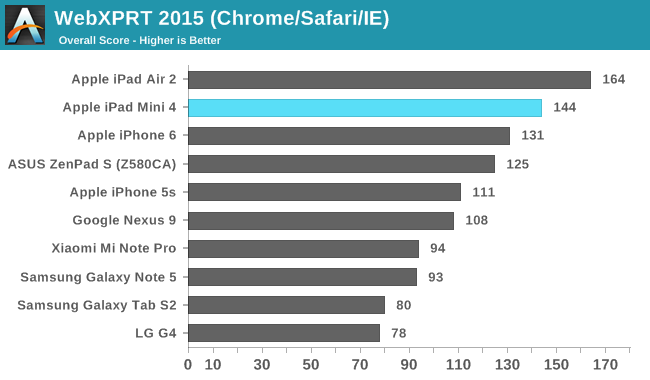
The interesting thing about JavaScript performance is that it's often bound by the performance of a single core. In this case the iPad Mini 4 does very well, and there's not a large gap between it and the iPad Air 2 despite the doubled L2 cache and additional core on the latter's A8X SoC. You certainly don't see anything even remotely close to a 50% lead for the Air 2 even though in a theoretical case where all cores are used entirely it would be 50% faster.

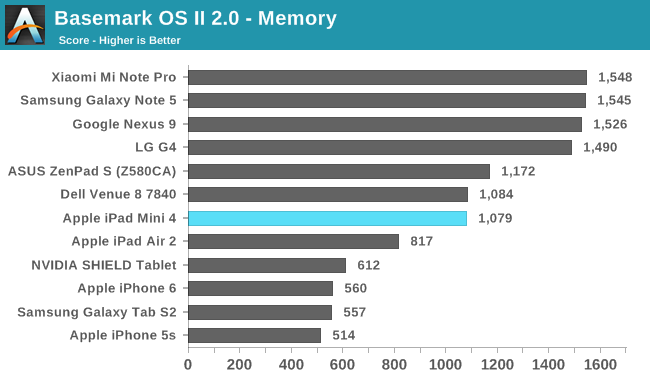
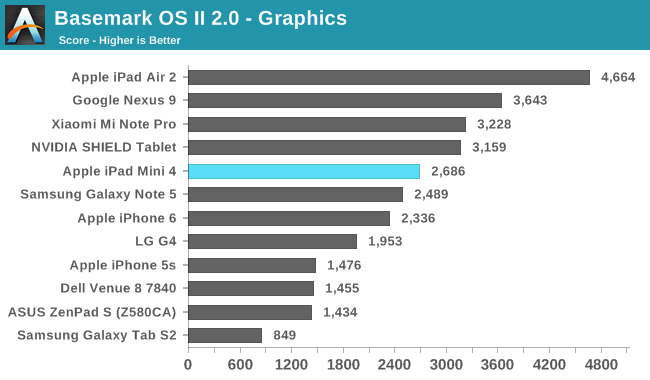
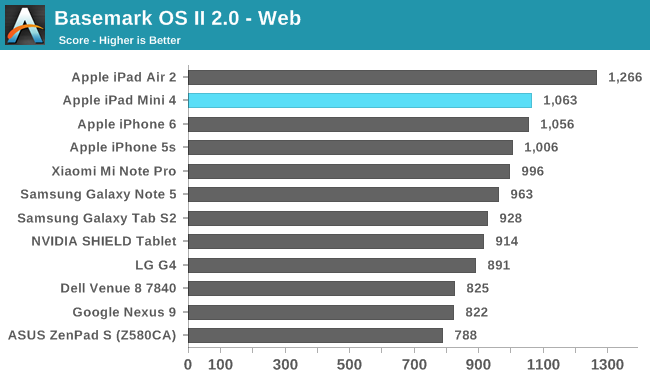
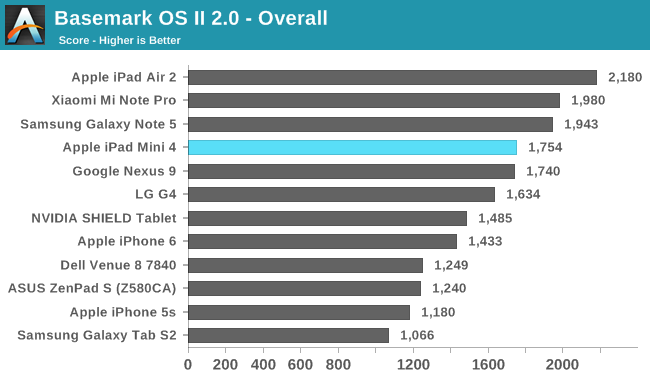
In BaseMark OS II's overall score the iPad Mini 4 is sitting right next to the Nexus 9, and both are relatively far below the iPad Air 2. However, it's important to analyze each sub test to see what areas a device excels at. Although it's right next to the Nexus 9 overall, the iPad Mini is significantly better in the system and web performance tests, while it falls behind in flash memory speed and graphics. Compared to the iPad Air 2 the Mini 4 falls behind in every test except for memory where it has a surprising lead. Looking at each test specifically, there's a tiny gap in web performance which echoes the results of our dedicated JavaScript benchmarks, and much larger gaps in system and GPU performance which makes sense as BaseMark OS II is designed in such a way that it will fully take advantage of A8X's triple core CPU and custom GXA6850 GPU in order to characterize their performance.
Overall I think the iPad Mini 4's general performance is right where it needs to be for a $399 small tablet. If you look at the results of the iPhone 5s you see that there is a significant gap between them in every test. The performance leap coming from the iPad Mini 3 certainly isn't like the leap that the original iPad Mini to iPad Mini 2 was when Apple moved directly from their A5 SoC to A7, but there's still a healthy improvement in performance across the board.
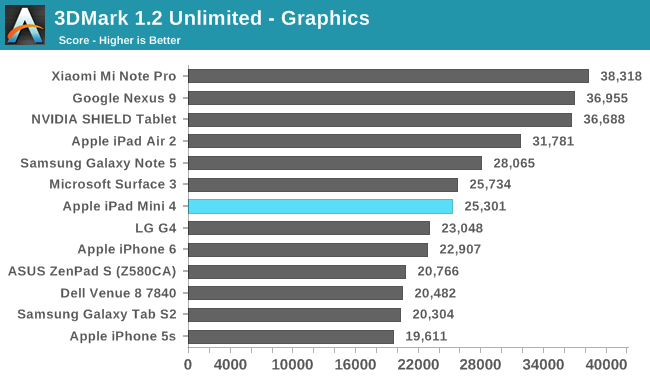

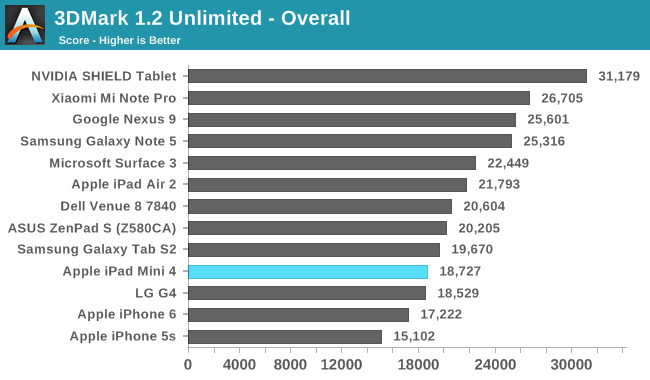
In 3DMark's overall score as well as both sub tests there's a small but noticeable gap between the Mini 4 and the iPhone 6. In the graphics test the Mini 4 is about 10% faster, while in the physics test the gap is a bit smaller at around 6%. The higher clocked CPU and GPU are definitely visible here, but the gap between the Mini 4's A8 SoC and the one in the iPhone 6 isn't enormous.
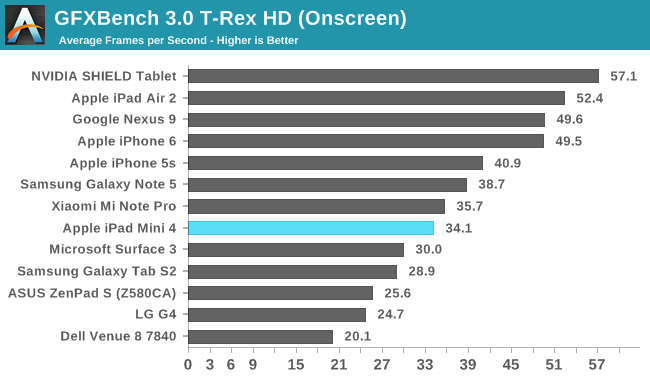
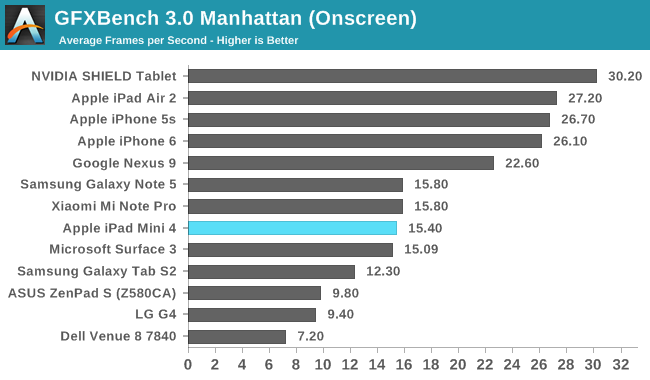
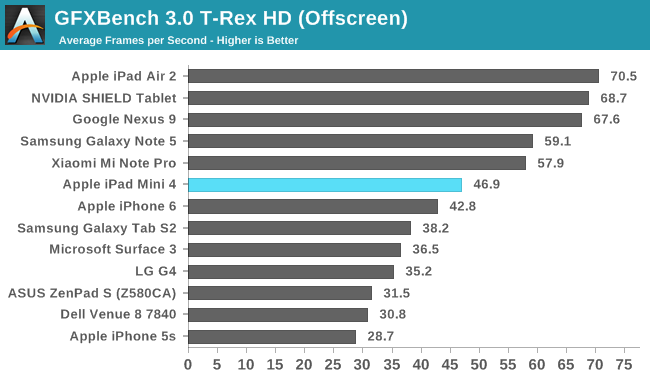

In GFXBench 3 the Mini 4 does pull ahead of the iPhone 6 when considering off screen 1080p performance, although with on screen performance the iPhone is much faster due to its lower resolution display. The level of graphical fidelity in the Manhattan benchmark is still too great to run consistently smoothly on the Mini at its native resolution, although a game with the visual quality of the T-Rex HD test would be playable at 2048x1536.
As I said earlier, the Mini 4's GPU performance is certainly not at the same level as the Nexus 9 or the iPad Air 2, but for a $399 8" tablet I think it's more than sufficient. One interesting point of comparison is the SHIELD Tablet, which was only $299 and has a very large lead over the Mini 4 as a result of its mobile Kepler GPU. It's also worth noting that while the Tab S2 model I reviewed was the 9.7" model, the 8.0" version should have identical results, and so the Mini 4 does have a decent lead over that. In the end the Mini 4 would have class-leading GPU performance if it weren't for the SHIELD Tablet, and NVIDIA definitely deserves credit for the level of GPU performance they were able to put into an 8" tablet. Even so, the Mini 4's GPU isn't going to have any trouble running the 3D apps or games on the App Store.
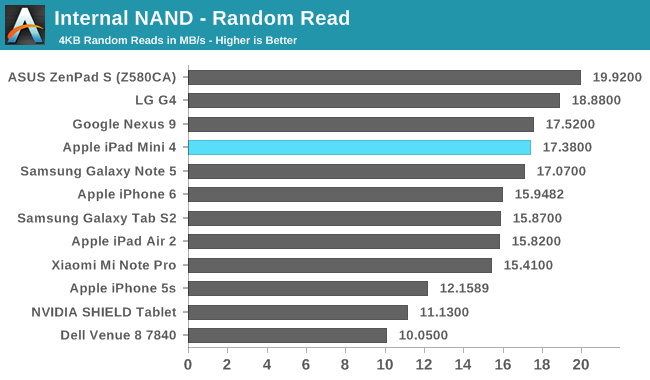
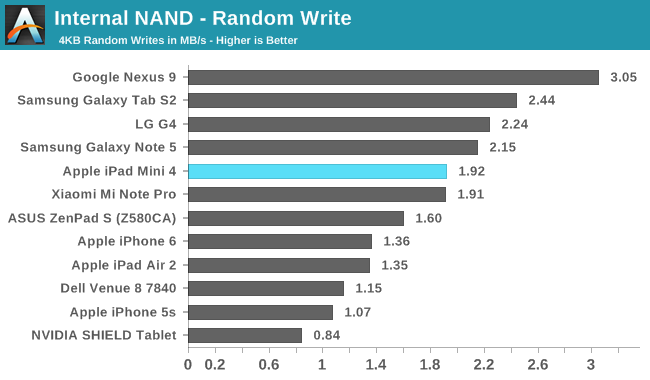
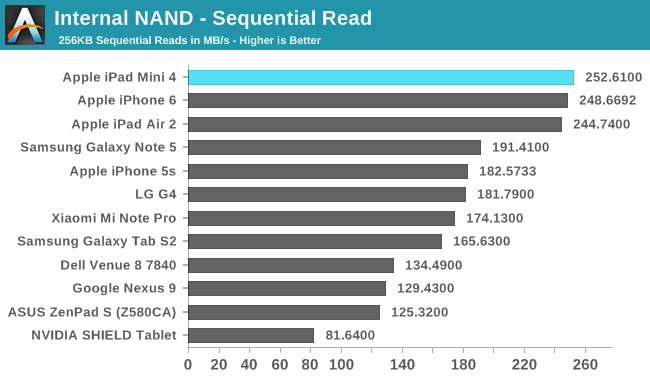
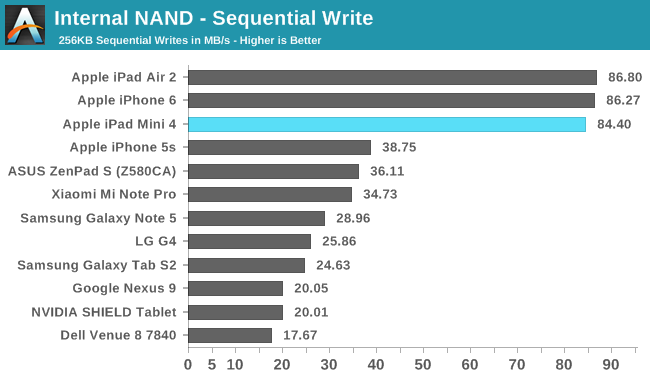
Storage performance on the iPad Mini 4 is where one would expect it to be. As usual, Apple excels when it comes to sequential reads and writes due to the use of SLC caching, with random read and write speeds also being very good, although not the best that we've seen on mobile devices. It's worth noting that my test model is a 128GB unit, and storage performance will be lower to some degree on the 64GB and 16GB models as flash storage uses parallelism heavily to improve performance by writing to multiple dies, and with a smaller storage capacity you have fewer dies to write to.










98 Comments
View All Comments
Speedfriend - Wednesday, October 28, 2015 - link
Any idea why this uses the 8 and not the A8X? Does that imply the chassis is not capable of dissipating the higher TDP of the A8X?michael2k - Wednesday, October 28, 2015 - link
I imagine they would have needed a bigger battery to offset the performance cost of the faster GPU and additional CPU core. Throw in a bigger battery and you have to make the iPad a fractional bit thicker, maybe 0.7mm, and another 14g heavier.And throw those three changes (more expensive CPU, more expensive battery, heavier iPad) and you need to bump the cost up just slightly, reducing margins just slightly, on top of the changes in the display that already increase the cost, and it makes sense why they sacrificed performance slightly. This is especially true when the A8 is already and still class leading a year later.
ThomasS31 - Wednesday, October 28, 2015 - link
This has nothing to do with cost... its just a decision to keep everything as thin and light as possible to appeal to the fans and consumers.Ivy said not long ago, they could make a thicker iphone to last longer (battery), but they do not want as it will not appeal as much to the consumers as the current thin phones.
Nothing to do with cost or price... just a decision, some of us like, and some of us not. :)
michael2k - Wednesday, October 28, 2015 - link
None of the outward justification is cost, of course, but they have to hew to a budget like everything else in the world. They increased the cost of the SoC, the memory, the cameras, and the screen, as is. Throwing in the more expensive A8X, the battery for said A8X, and the thicker shell to support both means they would have, as you said, lose the design goal of thinner and lighter. So there would be three reasons to stick to the A8:1) Thinner
2) Lighter
3) Cheaper
GC2:CS - Thursday, October 29, 2015 - link
Considering how energy efficient the Apple chips are, het deffinitelly isn't a problem.You has A8, even if a bit underclocked in an 6,1mm iPod touch. There it can almost perfectly sustain it's peak 1,1 Ghz CPU clock and GPU performance. iPad mini is just a much bigger device, there is more than enough room to dissipate heat, even if it would mean an A8X has to throotle a bit more aggressively than in Air 2.
A8X is a three billion transistor monster, it's big, it's pricey and since it's an X there is no stacked memory on it. That might be the reason - all iPad minis used PoP to save space and so I think that a possibility of an X chip in any iPad mini is quite small.
Also it uses a quite lot of power. If you look at that Gfx bench battery life test above, maybe Apple wanted to match them in terms of battery life under load.
And then while mini might be cappable of dissipating enough heat, Apple possibly didn't wanted the temperatures to go that high. iPad mini 4 is found to be rather cool running even under load.
But I doo agree that an A9 would be much better match. Even though it doesn't have 128-bit memory interface (What has it by the way ?) it bassically matches the performance of A8X, while being much smaller and lower powered, much more efficient than even A8.
Apple said that it's an shrunken down iPad Air 2. In terms of battery life, features, design, cameras display yes.
But with smaller size (and less matter to built a tablet from) there has to be compromise somewhere. Apple didn't matched the performance of Air 2, because it would require more advenced tech (A9) to do so in smaller device. But that would make it more advanced than an shrunken down Air 2 in terms of used tech. Bassically they built the best small tablet possible with let's say the same genertion of technology as iPad Air 2.
iPad mini 2 got smaller color gamut, iPad mini 4 got lower performance. And unless Apple invents a way to make those devices bigger from the inside, they can't defy physics.
Pneumothorax - Thursday, October 29, 2015 - link
Here's the thing, the A9 would've been an easy drop in the Mini 4 and would've matched/exceeded the Air 2 in most benchmarks along with giving better battery life and much less heat. Apple is just being Apple - milking the cow for all it's worth.NetMage - Saturday, October 31, 2015 - link
The mini's considerable price drop versus the Air or phone means giving up something.Drumsticks - Wednesday, October 28, 2015 - link
Thanks for the review. I always enjoy reading Anandtech reviews of Apple products. While I'm an Android/Microsoft guy (any hints on when to expect your 6P review? I'm sure it's a ways off but I'd love a hint!), I have a lot of respect for Apple's hardware engineering and SoC design teams. They do really, really great work, and it almost disappoints me that I dislike iOS (and to an extent, Apple. This is an opinion that is fully subjective and not looking to start a fight! There's plenty of reasons to like Apple).Apple has, for the last several years been a major driver of innovation in the whole industry, which is great. It's awesome to see (in my opinion) both Microsoft AND Google doing the same nowadays. All three of the big guys are driving the industry forward, and it's good for us all :D
amdwilliam1985 - Thursday, October 29, 2015 - link
Same here, I recommend Apple products to others(my parents and my brother all use iPhones), but when it comes to personal device, I'll go with Android/Nexus, will be picking up a Nexus 6P soon, when it's available in Hong Kong.ps: Personally, I want to support Google/Alphabet, don't want to give my money to Apple and then have it sit in their bank doing nothing(besides earning interests ;). It's just a personal believe, I believe with great power comes great responsibilities(Apple should be doing more to help the [tech] world). Luckily, there are always companies like Google who pushes on with crazy projects like Project Loon, Project Fi, Project Soli, Project Jacquard and etc...
I watch Apple WWDC and Google IO live every year, Google's event is just so much more exciting and inspiring to the tech geek in me. Apple's show is more about how they are the best and if you can't join them, then you're a loser kind of show, lol.
Knowing my money helps Google to help improving the world/tech helps me sleep better at night, lol.
lucam - Wednesday, October 28, 2015 - link
The A8 is still a good decent Soc from what I can see and I have a suspicion that in the Apple TV for not having similar thermal constrains and no battery it can go even faster...